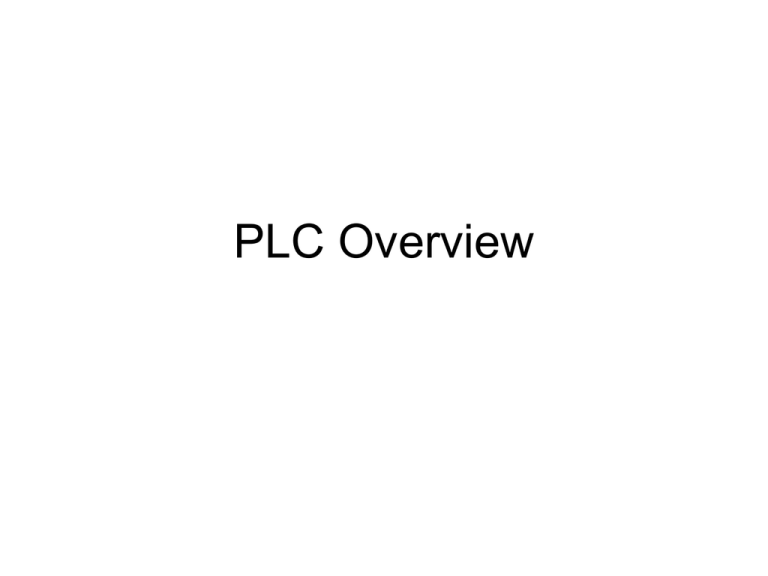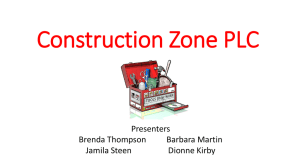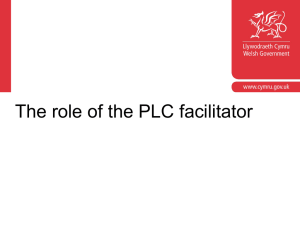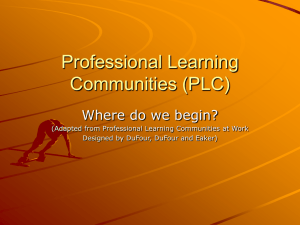PLC Overview - Educational Service District 113
advertisement

PLC Overview Resources Essential Questions: • What do you mean by PLC? • How do PLCs fit within your current structures? • What will your PLC do? • What is your plan to implement PLCs? Today’s Outcomes and Processes • Connect to prior learning • Myths and Legends of PLC’s • Benefits of PLC’s • PLC Readiness • Identify Necessary Conditions • Understanding Teams • PLCWashington.org • “T” Chart Activity • “123” Shoot Protocol • Using Surveys • 6 Hats • Discussion • Reflection • Engagement The Power of Professional Learning Communities The most promising strategy for sustained, substantive school improvement is building the capacity of school personnel to function as a professional learning community. The path to change in the classroom lies within and through professional learning communities. -Milbrey McLauglin, 1995 Educators in 100 different districts identified three broad areas of change that need to occur to improve student learning 1. Rethink and transform the current professional development paradigm. 2. Restructure the outcomes of teachers' professional development. 3. Re-culturing schools and communities for on-going, jobembedded teacher growth and professional development. Source: Southwest Educational Development Laboratory - SEDL What do you know about PLC’s? The BIG IDEAS of a PLC We accept learning as the fundamental purpose of our school (Students, Staff, Community) We are committed to working together to achieve our collective purpose. We cultivate a collaborative culture through development of high performing teams. We assess our effectiveness on the basis of results rather that intentions. We are Driven by the four foundational questions . . . Teams in PLCs Collaborate About the Right Things: 4 Critical Questions of Learning What is it we expect students to learn? How will we know when students have learned it? How will we respond when students don’t learn? How will we respond when students already know it? PLC’s are Learned Behaviors . . . With Great Benefits Myths and Legends Activity • • • • What have you heard from others about PLC’s? What do you want to know about PLC’s? What do you think a PLC is? What do you think a PLC is not? Is Staff Benefits Is Not Student Benefits A Professional Learning Community . . . Is . . . Educators Learning from each other Is . . . A collaborative process Is . . . Focused on student work and student learning Is . . . Focused on Instructional Practice Is . . . An empowering infrastructure of support Is . . . Effective professional development Is . . . Connected to the context of teachers’ classrooms Is . . . Action and results oriented Is . . . Continuous school improvement A Professional Learning Community . . . Is Not . . . A prescription Is Not . . . A new “program” Is Not . . . Just a book study Is Not . . . Forced on educators Is Not . . . Another fad Staff Benefits Reduced teacher isolation Collective responsibility for student success Increased understanding of the roles teachers play in helping all students achieve More satisfaction higher morale less absenteeism Southwest Educational Development Laboratory- SEDL Student Benefits Decreased dropout rate Less absenteeism Greater academic gains in comparison to traditional schools Smaller achievement gaps between students from different backgrounds Southwest Educational Development Laboratory - SEDL What is a PLC? Educators committed to working collaboratively in ongoing processes in order to improve student learning School Team Team Four Questions Results Team Each PLC is organized into a series of high-performing collaborative teams which meet on a regular basis to focus on student learning. Each Team uses the four foundational questions to drive reflection, action research, essential learnings, lessons, formative assessments, support, and enrichment . . . Resulting in . . . Improved Student Learning What is a Team? School Team Four Questions Results Team A team is a group of people working interdependently to achieve a common goal, for which members are held mutually accountable Organized by a shared course, shared subject, shared grade level, or interdisciplinary program. There has to be a logical reason for putting teams together Teams answer the four questions What are the Four Questions? Four Questions School Team Team Team 1. What do we want our students to learn? (Most essential curriculum 8-12 key learnings per semester) 2. How will we know they are learning? (frequent, team-developed, common, formative assessments) Four Questions 3. How will we respond when they don’t learn? (timely, directive, systematic interventions) Results 4. How will we respond when they do learn? (timely enrichment/extension) What is a PLC? • Time School Team Four Questions Results Team Necessary Conditions Team • Team Norms • Resources • Trust • Removing Barriers • Shared Knowledge • Job Embedded PD • Shared Purpose • Establishing Focus Team Defined A team is a group of people working interdependently toward a common goal for which members are mutually accountable. Not Teamwork Working as a Team What do PLCs and the Blue Angels have in common . . . ? What are your teams? • Discuss and share out your team structures… – What are your roles? – What questions are you exploring? – What support do you need in order to work more effectively as a team? Norms Purpose Teamwork Coaching Awareness Norms Trust Time Coach Data Time Professional Learning communities Trust Coach Trust Time Time Norms Data Data Protocols Collaboration Working with Adults Looking at student work WWW.PLCWashington.org Are you Ready for a PLC? 1,2,3, Shoot 1, 2, 3, Shoot Reflective Dialogue • Faculty/staff members talk with each other about their situations and the specific challenges they face. Not at all Somewhat 50% To a large degree To a great extent 1 2 3 4 5 Discussion: 1, 2, 3, Shoot De-Privatization of Practice • Teachers share, observe, and discuss each others’ teaching methods and philosophies. Not at all Somewhat 50% To a large degree To a great extent 1 2 3 4 5 Discussion: Finish “Shooting” 15 - 20 Minutes PLC Survey What barriers exist in your school? • Based upon the survey discussion or your experience… – What barriers exist in your school? – How do you plan to address them? – How will you engage others in this conversation? Initial Thoughts Time for Learning & Collaboration Removing Barriers Establishing Group Procedures Working as a team/Teacher Isolation Resources Facilitation Physical Proximity Necessary Conditions Challenge Cycle Developing Norms Worksheet When Establishing Norms, Consider Time When do we meet? Will we set a beginning and ending time? Will we start and end on time? Listening How will we encourage listening? How will we discourage interrupting? Confidentiality Will the meetings be open? Will what we say in the meeting be held in confidence? What can be said after the meeting? Decision Making How will we make decisions? Are we an advisory or a decision-making body? Will we reach decisions by consensus? How will we deal with conflicts? Participation How will we encourage everyone’s participation? Will we have an attendance policy? Expectations What do we expect from members? Are there requirements for participation? Proposed Norm Norms • • • Review your group norms… Write 2-3 behavioral definitions for your norm. (What does it really look like?) What will you do if norms are not followed? Protocols • • • • Clearly define roles Create safety through structures Are used purposefully Define time, expectations, procedures and products • Build trust Consultancy Protocol • Read overview of consultancy protocol • Watch video on PLC Washington and jot notes/initial thoughts on protocol description • Discuss possible use in your team 6 Hats Protocol Central Question or Proposed Change (6 Hats Protocol) Are we ready to implement this plan as presented? Six Hats Protocol 1. Proposed Future Change for the School 2. State the Central Question or Proposed Change so Everyone Understands 3. Assign One Color Hat to Six individuals (or subgroups from a larger group) 4. Each Color Hat will Focus on the Change or Central Question through the Lens of their Particular Hat Six Hats Protocol • White Hat = Data (Research, Effectiveness, Costs) • Black Hat = Caution (Downsides of this idea) • Red Hat = Emotion (How will people react to the idea? Who will like it? Who will be upset?) • Green Hat = Growth (Learn? Grow as a staff?) • Blue Hat = Process/Communication (who facilitates the process? How will this be communicated with stakeholders?) • Yellow Hat = Sunshine (Positive Aspects, Benefits? What good will come of this? ) Caution Data Emotion Should We Implement This Plan? Facilitate communication Positive Growth Central Question or Proposed Change Should we implement the plan as presented? "Unless you are prepared to give up something valuable you will never be able to truly change at all, because you'll be forever in the control of things you can't give up." — Andy Law Creative Company Protocol • Assign “hats” to team members • Take 2 minutes to write at least one question for your hat • Starting with the white hat: – – – – Pose question Team asks clarifying questions (2 minutes) Team discusses question (3 minutes) Repeat for all hats • Debrief – What questions remain unresolved? – What next steps do you suggest for your team? Something was missing… • What would you suggest to improve this protocol? • How could a protocol like this help you implement your team norms? Investigating Protocols • Read procedure and recourse in your packet. • Discuss protocols you would like to learn more about, or try with your team. • Next steps? Are you willing to investigate and implement a PLC at your school? 1. Write down your level of commitment on the sticky side of the sticky notes (so people can’t see the number when stuck on a wall). Don’t show anyone else in the group 2. Use a scale between 0% and 100% (in increments of 10 e.g. 40%, 70%, 10%, 90%) 3. Post on the ConSensoGram which produces a graph for a quick measurement check against the question above. Process Matters Question: How willing are you to investigate and implement a PLC at your school? 1 2 3 4 5 6 7 All of us are smarter than any one of us 8 9 10 My success is dependent on your success Group IQ There is such a thing as group IQ. While a group can be no smarter than the sum total of the knowledge and skill of its members, it can be much “dumber” if its internal workings don’t allow people to share their talents. -Robert Sternberg Questions? Time Bandit Why Professional Learning Communities? Staff identifying their own needs and developing learning experiences to meet those needs School-based and embedded in daily work Organized around collaborative problem-solving Continuous and on-going with follow-up and support Apply new learning within the context of the classroom Connected to a comprehensive change process Recognized by research to improve student learning Why Professional Learning Communities? PLC’s will be the P.D. of the 21st Century Schools are struggling with the Implementation of PLCs People are learning some of the “What” but not the “How” Necessary Conditions are not highly considered More authentic way to improve schools Focused on student learning and instructional practice






